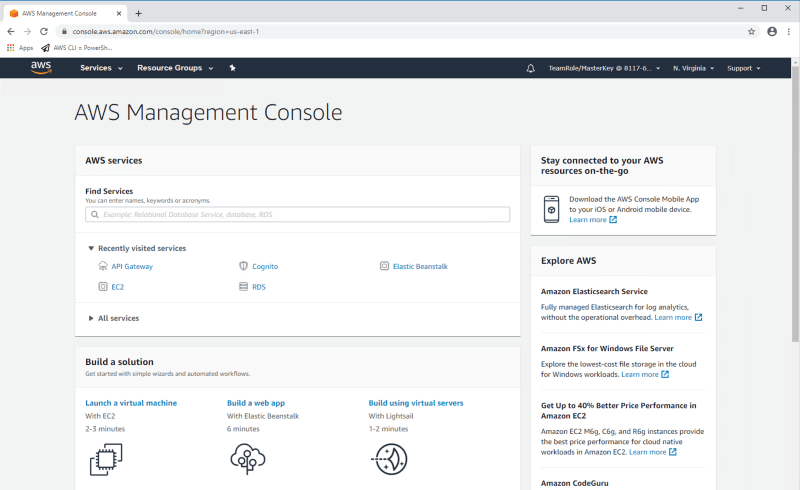Console Amazon Aws

Console Amazon Aws – The Amazon Web Services (AWS) console is a web application that allows users to manage and use various AWS services. The console acts as an interface that allows users to initiate events, create resources, and interact with Amazon S3 buckets. Access to the AWS console can be granted through a web browser or mobile app, and users need access to an AWS account and credentials to use it.
To get started, you need an AWS account and a web browser installed on your computer.
Console Amazon Aws

The AWS console offers several features that can be explored through the search tab or action menu. Customers can manage their monthly bills and access and manage AWS resources, including flexible cloud computing, cloud storage, and IT infrastructure. Users can also manage services such as AWS Identity and Access Management, Amazon Relational Database Services, and Amazon Autoscaling.
Usability Improvements For Aws Management Console Now Available
First released in the 1990s, AWS has continued to update and improve its console interface. The new console update offers an improved user experience, faster navigation, and faster access to multiple AWS services.
In general, AWS console access provides users with centralized access to a variety of AWS services, making it an essential component of efficient network and infrastructure management. However, this “word” makes it difficult to gain visibility into performance, utilization, and costs, especially for organizations with multiple AWS accounts and large numbers of self-service users across different lines of business. .
To address these challenges, AWS offers the free web-based AWS Management Console to manage AWS accounts, services, and users from a single dashboard. In some regions, the AWS console is available as a mobile app. The reviewers are appearing on the user interface – some reviewers love it; others are difficult to use. In fact, anyone accustomed to the user-friendly central control panel of web hosting platforms like Plesk or cPanel will find the AWS Management Console intimidating at first.
This article aims to introduce you to the AWS Management Console, which we hope will become your best friend as you manage your AWS deployments. And learn more about how Media Temple can help you migrate to the AWS Cloud and manage your AWS Management community!
Running Fds On Aws Parallelcluster 3 At Scale
When you first log in to the AWS Management Console for your account, the home page will look like Figure 1 below. Different sections of the AWS Console home page are portals where you can navigate to AWS services, solutions, and training resources, as well as third-party tools on the AWS Marketplace.
From the AWS Management Console, you can access consoles and dashboards for the various services you use in your AWS deployment. In this section, we’ll explain how to navigate to a service and look at a typical service console using IAM as an example.
There are several ways you can navigate from the AWS management console to the service dashboard (Figure 2).

You can open the job status window as shown in Figure 3 by clicking Services (Figure 2: 1) in the navigation bar. There you can..
Navigate Aws Console To Access Different Aws Regions And Services
You can also click on the “Find a job” text field (Figure 2: 2) to open a list of all job letters, scroll to the job you want, or use the text search to narrow the list.
There are also two convenient shortcuts for frequently used functions. The first provides an AWS console that maintains a list of recently visited services (Figure 2:3). Another feature is the ability to pin a task to the navigation bar by clicking the Pin icon, opening an alphabetical list of tasks, and then dragging the task icon to the navigation bar. You can cancel the service by entering your PIN and dragging the service icon from the navigation bar.
In the grinding wheel. The only difference is that the view is still sorted and there is no recently visited console history.
AWS Identity and Access Management (IAM) is a critical security service that allows you to define and control role-based access to AWS resources and services. Here we use IAM as an example of how a specific service console looks in the AWS management console.
Using Spack On Aws Parallelcluster
On the left (Figure 5:1) there is a clear menu of various elements to define and manage in the IAM service (groups, users, roles, etc.), and the control panel is the home page of the work.
In the middle (Figure 5: 2) is a dashboard showing the IAM resources defined so far and the Security status defined in five main steps (shown in Figure 6 below).
On the right (Figure 5:3) are links to specific work information and resources, including video presentations, best practice guidelines and policy practices.

As shown in Create Each IAM User in Figure 7, click the button to access the information step and the corresponding function.
Amazon Web Services Console
However, the interface for adding, removing, and modifying users, groups, policies, etc., guides you step-by-step through the necessary actions, many of which are point-and-click.
An AWS appliance is something you can run, such as an Amazon EC2 or Amazon S3 bucket. A resource group is any number of resources in the same region that all meet the same query criteria. Requirements can be that all resources are assigned the same user-defined label or all belong to the same AWS CloudFormation infrastructure stack.
Resource groups are very useful for gathering insights or taking action on related resources. For example, you can use resource groups to apply updates or security patches to a collection of Amazon EC2 hosts, or you can collect, monitor, and view information about all relevant Amazon EC2 instances tagged at a specific application level.
You can view saved groups, create groups, and edit tags through the Resource Groups drop-down menu in the AWS Management Console navigation tree. Selecting either option opens the AWS Systems Manager console, as shown in Figure 8 below.
Gaining Aws Console Access Via Api Keys
The AWS Systems Manager navigation panel (Figure 8:1) provides easy access to create, manage, and perform actions on resource groups. When creating a group, specify the query criteria (Figure 8:2) as either the label source or the CloudFormation stack source. Next, define group criteria by selecting the appropriate resource type (Figure 8: 3) and add the desired tags (Figure 8: 4). Although not shown in Figure 8, the next steps are to select the resources you want to be in the group, give the group a name, give a group description, and add key characters / group values (optional). .
The AWS cloud is located in 20 geographic regions around the world. The cost of services varies by region, so the region(s) where AWS services are deployed will have a significant impact on cloud costs. The region the app is running in can also affect data visibility and other app performance metrics. In addition, some industries have regulatory restrictions on the country or region where cloud resources are hosted, so choosing an AWS region can be a compliance issue.
Some services, such as IAM, are global. Most AWS services expect you to specify a Zone endpoint when you access the service, but some, such as Amazon EC2, do not allow you to specify a Zone endpoint. In these cases, AWS defaults to the us-east-1 region.

It is important to remember that the resources allocated to each region are independent of each other. Companies use it for high availability (ie, maintaining redundant sites in one or more regions). But this means that at any time, the AWS Management Console displays the services that belong to the currently selected region on the left side of the navigation bar. When you navigate to a service implemented in a specific region, the region on the navigation bar automatically updates and stays in that region until you click the arrow to select a different region.
How To Configure A Relational Database Server On Aws
You can access the Billing and Pricing Information Dashboard through the AWS Management Console. This free AWS service provides all the tools you need to visualize your AWS usage and costs in real-time, including monthly cost estimates and monthly service usage, as shown in Figure 9 below.
Understanding AWS billing rates and policies over time is an important first step in owning and optimizing cloud spending. For example, you may find that automated workflows don’t stop running tools you provide that aren’t working. Alternatively, you can explore discounted payment options, such as prepayments or backups.
Understanding all of the financial analysis dashboards and pricing features is beyond the scope of this article, but we recommend reviewing the AWS documentation on a monthly basis.









No Comments